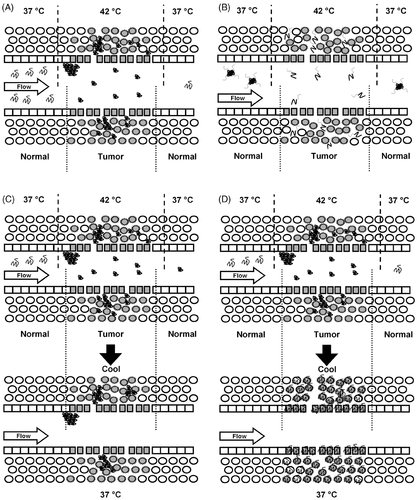Figures & data
Table I. Categories of thermo-responsive peptides.
Figure 1. Strategies for designing anti-tumor temperature sensitive peptides. Images depict peptide drug carriers flowing through permeable tumor vasculature during or after local hyperthermia. (A) An associating peptide accumulates into depots within hyperthermic tumor regions. (B) A disassociating peptide micelle disassembles within hyperthermic tumor, and monomeric peptides diffuse rapidly into the tumor. (C) An irreversible-associating peptide is retained in depots after the tissue cools to body temperature, contacting a subset of cells. (D) A reversible-associating peptide floods the tissue with concentrated monomeric peptides after the tissue cools to body temperature, contacting most of the cells.

Figure 2. Elastin-like polypeptide block copolymers: affinity modulated switches. (A) An ELP block copolymer with a hydrophilic [V1A8G7-96] amino terminus and a hydrophobic [V5-60] carboxy terminus. Also indicated are an amino terminal NGR peptide ligand (half-ring) and a carboxy terminal therapeutic agent (lightning bolt). At body temperature the ELPs are monomeric, but at 42°C the ELPs assemble into spherical micelles decorated with multiple ligands. (B) Hydrodynamic radius and optical density as a function of temperature for ELP block copolymers with and without the NGR peptide ligand. For 25 µM peptide, Both ELPs are monomeric at 37°C and multimeric at 42°C. Error bars indicate polydispersity. (Reproduced with permission Citation[30]).
![Figure 2. Elastin-like polypeptide block copolymers: affinity modulated switches. (A) An ELP block copolymer with a hydrophilic [V1A8G7-96] amino terminus and a hydrophobic [V5-60] carboxy terminus. Also indicated are an amino terminal NGR peptide ligand (half-ring) and a carboxy terminal therapeutic agent (lightning bolt). At body temperature the ELPs are monomeric, but at 42°C the ELPs assemble into spherical micelles decorated with multiple ligands. (B) Hydrodynamic radius and optical density as a function of temperature for ELP block copolymers with and without the NGR peptide ligand. For 25 µM peptide, Both ELPs are monomeric at 37°C and multimeric at 42°C. Error bars indicate polydispersity. (Reproduced with permission Citation[30]).](/cms/asset/b69f4fca-06b9-479f-b7d7-68fe38562171/ihyt_a_315123_f0002_b.gif)
Figure 3. Pharmacokinetics and tumor accumulation of elastin-like polypeptides. 14C labeled ELPs were administered via tail vein to nude mice for an initial plasma concentration of 25 µM. (A) Whole blood pharmacokinetics were determined over 24 hours. The ELP1[V5A2G3-150] concentration was determined and fit with a bi-exponential solution to a two compartment model to obtain the indicated half-lives. (B) A temperature sensitive ELP1[V5A2G3-150] (Tt = 39°C) and a temperature insensitive ELP2[V1A8G7-160] (Tt = 53°C) were administered to mice with subcutaneous FADU tumors in the right hind leg. Immersed in a water bath, the leg and tumor were heated to 41.5°C for 1 h before isolation. * indicates that ELP1(heat) was significantly (p < 0.05, Fischer's PLSD) greater than either control. Error bars indicate the standard error of the mean (n = 5). (Reproduced with permission Citation[33]).
![Figure 3. Pharmacokinetics and tumor accumulation of elastin-like polypeptides. 14C labeled ELPs were administered via tail vein to nude mice for an initial plasma concentration of 25 µM. (A) Whole blood pharmacokinetics were determined over 24 hours. The ELP1[V5A2G3-150] concentration was determined and fit with a bi-exponential solution to a two compartment model to obtain the indicated half-lives. (B) A temperature sensitive ELP1[V5A2G3-150] (Tt = 39°C) and a temperature insensitive ELP2[V1A8G7-160] (Tt = 53°C) were administered to mice with subcutaneous FADU tumors in the right hind leg. Immersed in a water bath, the leg and tumor were heated to 41.5°C for 1 h before isolation. * indicates that ELP1(heat) was significantly (p < 0.05, Fischer's PLSD) greater than either control. Error bars indicate the standard error of the mean (n = 5). (Reproduced with permission Citation[33]).](/cms/asset/63bb9440-c0f2-43ed-9a64-bb8b1ef35cad/ihyt_a_315123_f0003_b.gif)